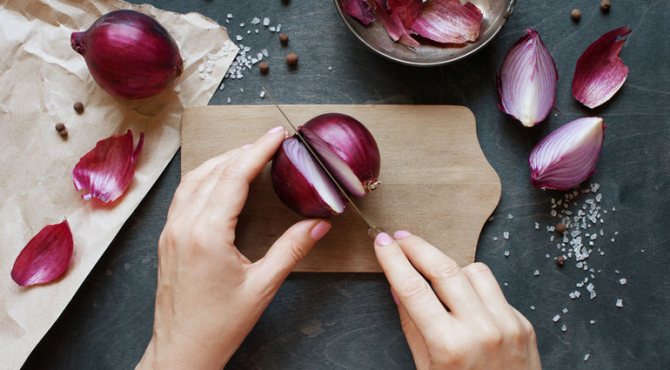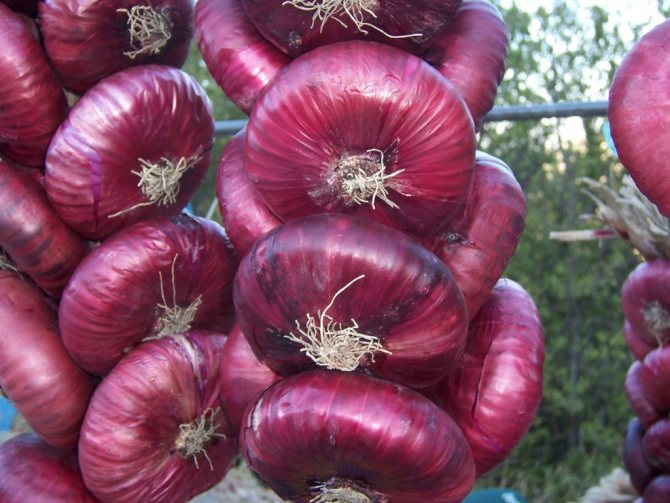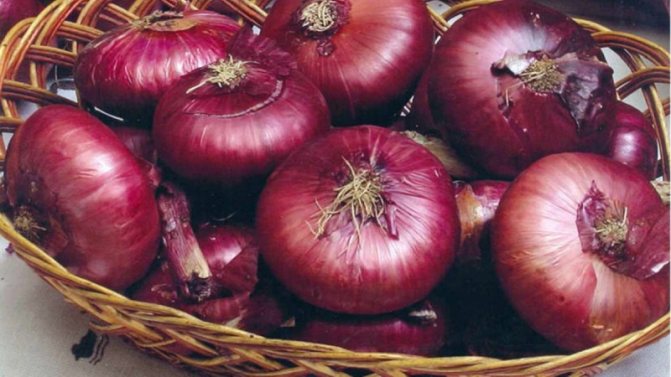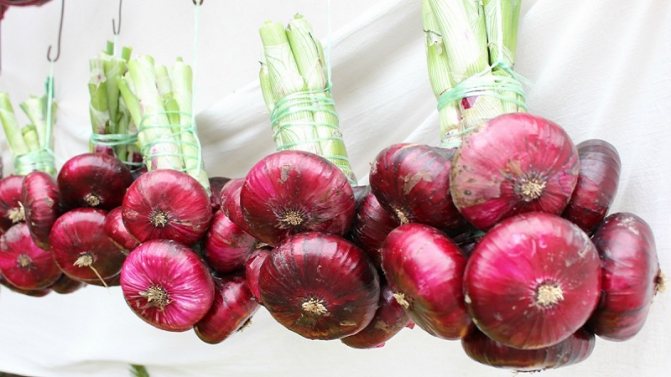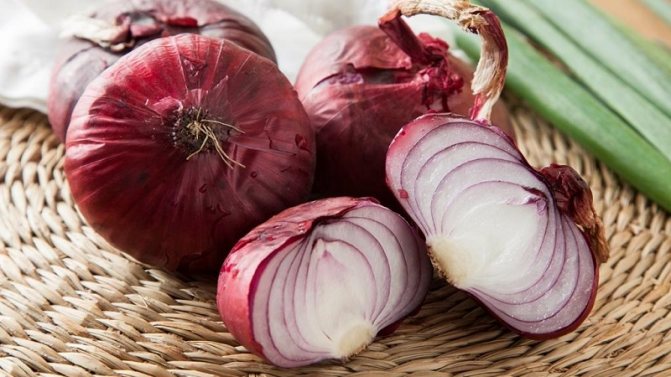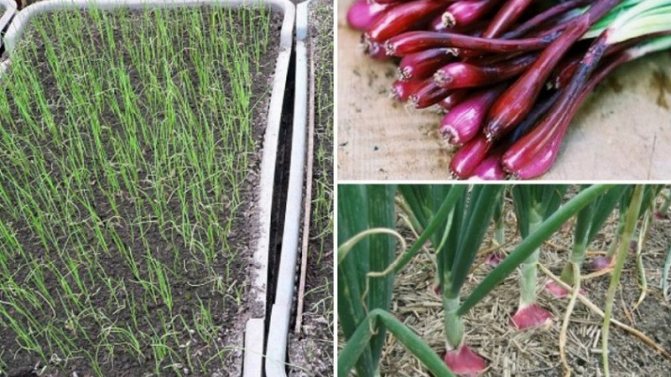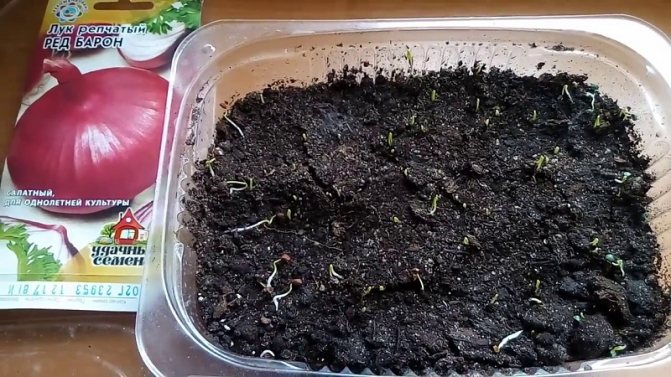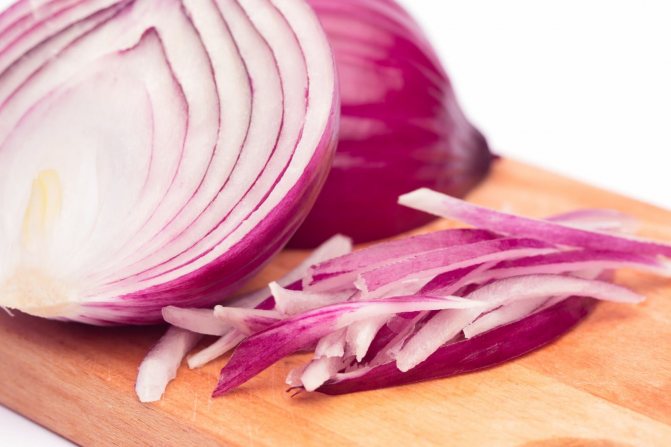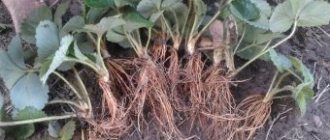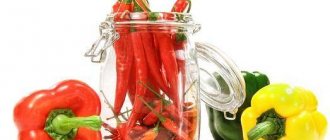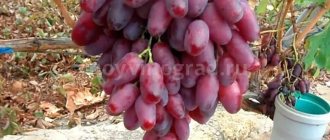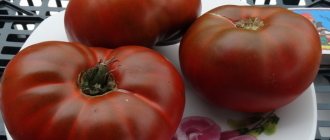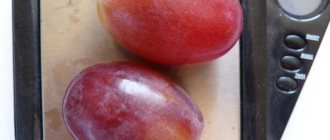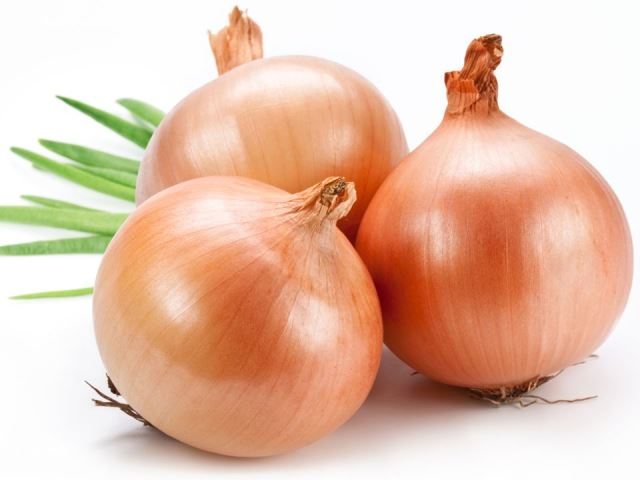
Onions are used for cooking many dishes, so any housewife, when choosing crops for growing on her site, prefers several varieties at once. Variety in the beds allows you to create new masterpieces in the kitchen, and at the same time improve your gardening. In this article, we will find out what types of onions are, home and wild, talk about their description and find out the main characteristics.
Varietal variety of onions: what types are there?
Adopting the experience of their ancestors, preference is often given to the same varieties of onions when planting a vegetable garden. It's time to change stereotypes, improve and achieve new results, because the dish can sparkle with new flavors if you use Setton or Leek instead of the usual onion. Moreover, in central Russia, you can plant a large number of varieties, as practice has shown. At least lettuce, even green. And then we will find out where which species can grow.
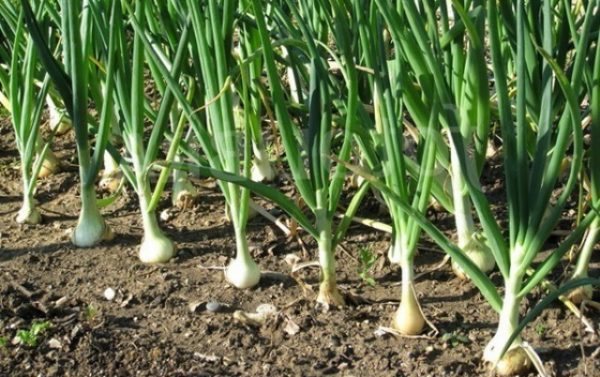

Onions in the garden
The most popular onion varieties
All varieties of culture differ not only in taste, but also in planting rules, ripening period, and yield.
Onion sets
- Chalcedony grows outdoors, is very popular among gardeners in the southern regions of Russia. Suitable for growing feathers and root crops. The ripening period (from planting to harvesting) is 95-110 days. An average of 4 kg is removed from a square meter with a marketable weight of one small specimen of 85-100 grams. Sometimes there are onions weighing up to 400 grams. There is a good immunity to peronosporosis, vulnerability to cervical rot. Taste: pleasant with a slight spice.
- Stuttgarter Riesen early ripening, from sowing to harvesting takes about 3 months. Rounded-flat onions weigh 150-250 grams on average, but there are also giants up to 350 grams. The plant rarely shoots arrows, does not become covered with spots typical of downy mildew. Taste: spicy with a pungent aroma.
- Sowball is characterized by large, rounded bulbs with an average weight of up to 200 grams. The root crop ripens for about 100-110 days, gives a good harvest. Taste: delicate with a slight hint of pungency, used mainly for salads.
Onions (turnip)
- Goldfish represents a mid-season species, differs in round, medium-sized onions weighing about 60-70 grams. Used for greenery and growing turnip for planting in the next season. The middle is white and juicy with a slight edge.
- The shaman belongs to the early ripening varieties, ripens in 86-95 days. The root crop has an elongated shape, a pink-red rather juicy middle. The average weight of a turnip is 55-65 gr. Advantages: stable high yield, high taste. Stored for a short time.
- Oporto matures in 98-107 days, belongs to the mid-season species. The weight of the turnip reaches 270-300 gr., The shape is correct round. Advantages: high yield when using seedlings, immunity to diseases and pests, retains its presentation for a long time. The palatability allows the use of porto for all types of processing.
Varieties of salad onions
- Exibishen ripens for about 130 days and tastes very sweet with abundant juice. Turnips are round and very large, reaching 550 gr., But there are also specimens of 700-800 gr. The only drawback of the culture is considered a small storage period (no more than 3 months).
- Yalta is incredibly popular due to its excellent taste. The plant ripens in 138-150 days, turnips are large flattened purple tones, reaching an average of 200 grams. In the middle lane, the variety can be grown using seedlings. Onions are stored for up to 4 months.
- Ermak is the ripening record holder, the crop is removed 75-95 days after sowing. Differs in good immunity, long shelf life (up to the next season). The gastronomic feature is a soft juicy texture with a slight pungency.
Red onion
- The crimson ball ripens in 85-95 days, yields a stable harvest every year. Dark purple rounded turnips live up to the name. The middle is juicy with a pleasant taste, set off by a light speck. The drawback is the short shelf life (up to 4 months).
- Campillo F1 Introduces Red Onion Hybrid, which has a rounded shape with a dense center and a pleasant purple tint. Advantage - pigment does not transfer to kitchen utensils and fabrics. Taste qualities: delicate structure with abundant juice production, well-perceived sweetness. It can be stored for a long time without losing its properties.
- Retro is famous for its high yield and fast ripening (up to 90 days). The middle is tender, dark red with white stripes. Onions are very sweet without pungency, so they are even added to children's salads.
White onion
- Albenka is fast ripening (up to 95 days) and interesting taste qualities that combine light pungency and sweetness. Grown for herbs and onion sets. Not suitable for long-term storage.
- The white globe has good seed germination and quick ripening. You can harvest the crop in 95-105 days after planting. A rounded, slightly elongated turnip weighs 160 grams on average. The variety has a high stable yield, immunity to fusarium.
- Sterling is a group of white onion hybrids with a ripening period of 110-120 days. The mass of an average turnip is 120-200 gr. Rounded shape with white husk. The middle is soft and juicy with an unusual taste that is not similar to other species. The storage of the root crop is short (3-5 months), but when grown, immunity to many diseases and pests is noted.
Sweet onion
- Kaba matures in 145-155 days, is immune to disease. Productivity is stable, stored for up to 4-5 months. The weight of a round turnip with a slight pressure is 80-125 grams. The middle is dense, but sweet and juicy.
- Globo ripens 110-125 days, the size of the root crop is a real giant. The weight of one onion reaches 600-900 grams. The taste is delicate, sweetish, ideal for salads and various other dishes. Growing a crop from seedlings, you can get a crop from 1 m2 to 12 kg.
- Spanish 313 is distinguished by its yield, immunity to diseases and pests, suitable for fresh and processed consumption. The weight of an average turnip is 120-150 grams, the shape is round and large. Onions have long been recognized by domestic gardeners and are popular due to their unpretentious care and sweet taste. Productivity from 1m2 - 4-5 kg.
"Hercules"
It is a light yellow hybrid from the Dutch breeding, it has the most rounded shape among other varieties. In dry conditions, it is stored longer than other types. Taste characteristics are gentle and slightly pungent, which gives another advantage to this variety. The bulb forms very strong and deep roots. This will prevent drought from killing the plant. Refers to varieties with high yields and resistance to viruses.
Important! Onion sets "Hercules" for one square meter of sowing brings up to 8 kg of yield, which its relatives cannot boast of.
Planting can be done in the fall, when there is still no frost. The optimum temperature regime is 10 ° C. It is better not to overfill the seedling with water. After all, if you exceed the moisture rate, then the vegetable will not be stored for a long time and will quickly rot.
The best bulbs for the Moscow region
- Centurion has gained popularity all over the world due to its high taste. The rounded-elongated turnip reaches a weight of up to 110 g... The yield is average, but stable (up to 3-4 kg per 1 m2). Advantages of the variety: not susceptible to the release of arrows, long shelf life (up to 8-9 months), resistance to decay. The root vegetable has a pungent taste.
- Hercules is considered a prolific crop, yielding from one square meter to 8-9 kg of root crops. Breeders, working on a hybrid, initially set the task of obtaining a long-lasting onion. The result exceeded expectations - good resistance to diseases, long-term storage without loss of useful properties, resistance to the whims of nature. The weight of the turnip is up to 120 gr., The taste is at a height (light pungency, juiciness, moderately sweet).
- Sturon represents a hybrid grown by Dutch breeders. As a result of painstaking work, a variety was obtained that is resistant to diseases and pests, which retains its presentation well for 9-10 months. The plant ripens in 100-115 days, the weight of an average turnip is 120-150 grams. Gastronomic peculiarity: suitable for all types of processing, neutral flavor notes with a slight spice.
Observing all the recommendations for soil preparation, planting and care, you can remove a completely bountiful harvest of onions from the beds. And even celebrate a giant root crop every year, winning their own records.
There are several varieties of onion plants that form a marketable turnip. Their basic biochemical composition is similar, but there are some differences. Red onions have not only colored dry scales, but also flesh. The active substances contained differ in composition from the yellow and white types. High taste, nutritional value served to spread it in cooking. Useful properties allow the vegetable to be used for medicinal, cosmetic purposes.
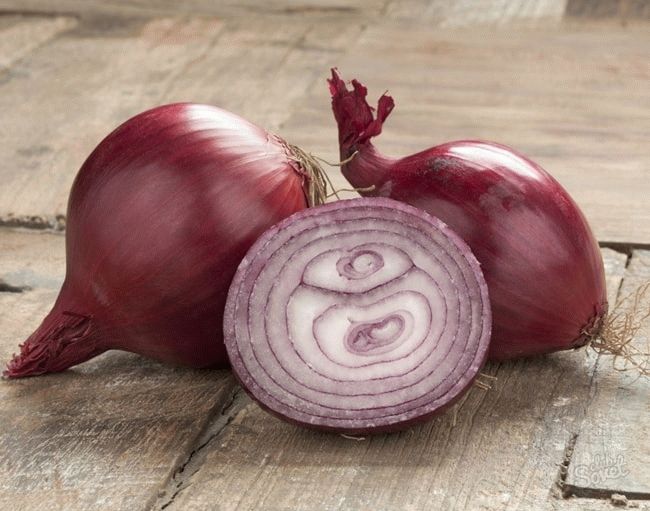

The nuances of care
When growing red onions during the season, the feather is not cut.as this prevents the development of large bulbs.
Watering mode
Throughout the growing season, onions are watered abundantly daily... An insufficient amount of moisture leads to the growth of feathers and the cessation of the formation of bulbs, and an excess of moisture leads to fungal diseases.
By August, daily watering is replaced with watering once a week., which prevents the bulbs from soaking and rotting and lengthens the storage period.


Loosening the soil, weeding and feeding
In the spring, the soil is gently loosened with a rake.... In the future, shallow loosening of the row spacings is carried out until the stems of the plant are closed.
Planting is fed during the entire ripening period:
- First feeding (slurry diluted with water 1:10) is carried out 2-3 weeks after planting. Consumption - 1 bucket per 2 m².
- Second feeding (wood ash - 0.5 liters per row) is carried out during the formation of bulbs - at the end of June.
Once in May and twice in June, the onion is watered with an aqueous solution of mineral fertilizers low concentration (20 g of the drug per bucket of water).
Disease and pest control
Properly prepared purple onions are not afraid of pests and practically does not get sick.
However, in late June - early July, it is advisable to sprinkle the beds with makhorka for added protection against onion flies.
Growing difficulties
When growing purple onions face the following difficulties:
- It is difficult to get a sweet taste in a summer cottage. Onions planted in normal fertile soil take on a bitter taste.
- It is necessary to carefully care for the seedlings.
- Purple onions have a high demand for watering and heat when growing outdoors.
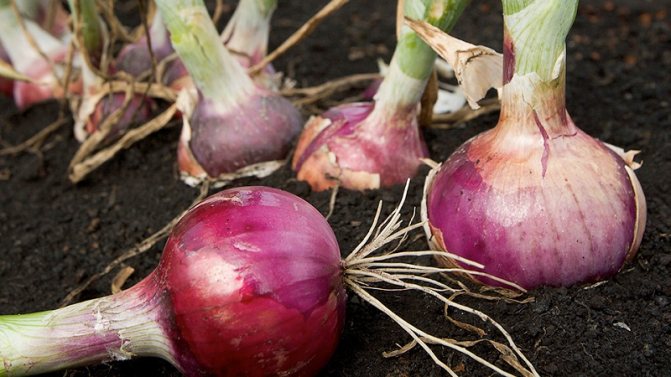

Origin and description of culture
Central Asia is considered the birthplace of culture. Then the red onion was bred in the Nikitsky Botanical Garden. The varieties that grow between Alushta and Yalta are delicacies. Today it can be grown everywhere, many hybrids with improved characteristics have been created.
The red onion got its name due to its red-violet color. The outer dry scales are intensely colored, and the flesh is lighter. The shape of a turnip is similar to a regular onion, it can vary depending on the variety. The bulb reaches 15 cm in diameter, the feather is long, the peduncle grows up to 1.5 m in height.
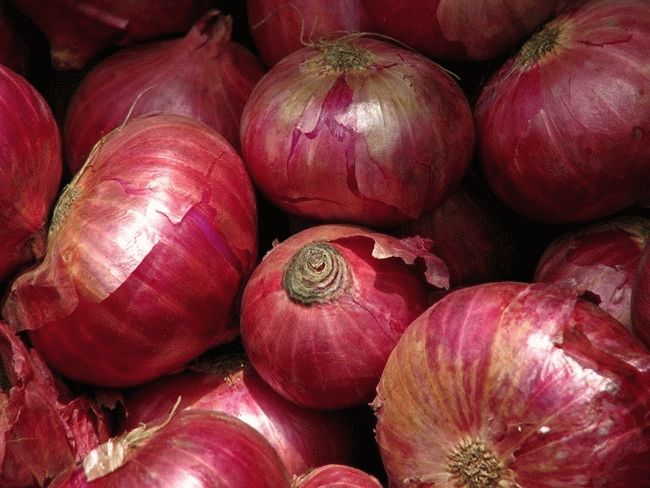

The nutritional value
100 g of onion pulp accounts for:
- proteins - 1.4 g;
- fat - 0.1 g;
- carbohydrates - 9.1 g
The energy value depends on the variety. The average number of calories is 42 kcal per 100 g. The calorie content of red onions is not the lowest among similar crops. But due to its biochemical composition, which provides beneficial properties for burning fat and reducing the absorption of fats, it can be used in dietary programs for weight loss.
Chemical composition
The properties and effects of a plant on the human body are explained by the content of various active substances in it. Red-purple onions are composed of:
- vitamins A, C, E, H, PP, group B, β-carotene;
- minerals - calcium, iron, magnesium, sulfur, chromium, selenium, zinc, copper;
- quartztin, which has a broad spectrum of action;
- anthocyanins, which cause a purple-violet color;
- antioxidants that slow down the aging of the body;
- essential oils;
- organic acids.
Difference from other types of onions
There is little difference between this species and a white or yellow vegetable. The main difference from the usual one is the reddish, with a purple tint of the pulp and dry scales. The biological value for some indicators is higher. Red onion differs from white onion with more fleshy pulp and a sweet taste. Cooking uses are less varied than that of the yellow species. It is mainly used for making salads, marinades, fresh sauces.
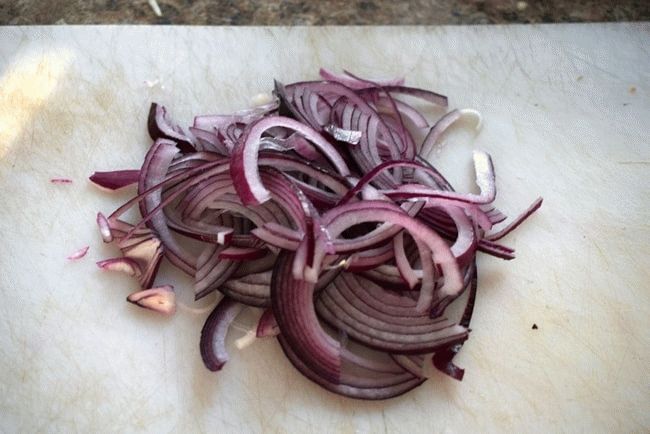

Varietal variety
Taste, appearance, growing season depend on the variety. The red vegetable is considered to be sweeter, with a delicate taste, but it is found no less spicy than the usual onion. This mainly depends on its variety, territory and growing conditions.
- Black Prince - mid-season, long-term storage, semi-sharp;
- Crimson ball - early ripe, used fresh;
- Retro - early, high yielding, sweet taste;
- Greatful is a mid-season hybrid that can be stored for a long time;
- Yukont - ripens quickly, has good keeping quality, spicy taste;
- Campillo is a hybrid, has a mild taste and is resistant to diseases.
"Carmen"
This is one of the Dutch varieties of onion sets that have recently been imported into our country. However, he is very popular. One of its advantages is its ripening speed, which ranges from 75 to 85 days. It normally tolerates storage for the whole winter. From a square meter, you get, at best, up to 2.5 kg of harvest.
The bulb weighs up to 80 g on average, but with proper planting, good soil and under favorable conditions, it is possible to get a bulb weighing up to 120 g. Carmen onion sets have a bright red color and ellipsoidal shape. Inside, the color is even more saturated, dark purple. Excellent taste:
- juicy;
- sweetish;
- weakly sharp;
- has a pleasant aroma.
Therefore, it is added to fresh salads. This vegetable is useful for people with low cholesterol levels for regular consumption.
Beneficial features
The benefits and harms of red onions have not yet been fully understood, but the spectrum of effects on the body is wide, affecting almost all organs and systems.Regular use of turnip leads to an improvement in the functioning of the digestive system, the metabolism is restored, and the absorption of fats decreases. The body is cleansed of toxins, the risk of developing oncological neoplasms in the intestine is reduced.
Red onion helps to reduce bad cholesterol, cleanses blood vessels from cholesterol plaques. Thanks to this, the risk of stroke, heart attack becomes less. There is a decrease in blood pressure, headaches disappear.
Red onion has an effective antiviral effect, which helps to maintain health during epidemics.
Quarcetin removes excess fluid from the body, reduces swelling. Thanks to the vegetable, the lungs and bronchi are cleared of a viscous secretion that causes coughing. The blood sugar level goes down. Active substances also destroy parasites and pathogenic bacteria. It is difficult to overestimate the importance of red onions for health, its benefits extend to people of all ages, regardless of gender.
Possible harm and contraindications
Red and purple onions can only be harmful if consumed excessively. It should be eaten with caution and in small quantities for asthma and hypertension. There is a risk of developing diarrhea. It is undesirable to eat a turnip grown with the use of pesticides, chemicals.
It is necessary to keep in mind the contraindications:
- diseases of the liver, kidneys, gastrointestinal tract;
- increased acidity of gastric juice;
- bloating;
- pancreatitis;
- colitis;
- allergy;
- some skin diseases;
- individual intolerance.
Applying red onions
In cooking, it is used mainly fresh, this is how all the useful substances remain in its composition. The vegetable can be added to salads, cold snacks, grilled, baked in the oven. Despite the fact that heat treatment destroys some of the nutrients, it is stewed, boiled or baked onions that need to be eaten to reduce sugar, normalize the work of the pancreas. Cooking in this way allows people with high acidity in the stomach to use it.


Fresh, beautifully shaped bulbs are used to decorate salads and other dishes with them. Flowers cut from a turnip using the carving technique look realistic, do not require food coloring to diversify the color scheme. They are often made for buffet and festive tables.
The sweet onion is suitable for feeding children. The juice irritates the gastric mucosa less, and the beneficial properties are no less pronounced, vitamins and minerals are present in full. Also, sweet varieties are desirable in the diet of pregnant and lactating women.
Widespread use in folk medicine. Proven recipes have been developed for ARVI, cleansing the liver, removing worms from the body as a diuretic. Onion juice is used for otitis media. Gruel from the pulp helps relieve pain, start recovery processes in case of injuries and sprains. Onion broth is used for corns. Red onions restore ligaments, which is needed during heavy physical exertion. The high amount of antioxidants makes the vegetable essential for maintaining youth, health and beauty.
The benefits of onions are known to everyone. There are many varieties of this vegetable, differing in properties, appearance, color. The purple onion is known for its beneficial effects. This vegetable is used in nutrition and folk medicine. What vitamins are in onions, described in the article.
Description
Onions are a plant native to many countries. There are about 400 of its species. Among them is red onion, which has a rich purple color. The shell of the vegetable is shiny. The culture is known for its immense benefits.


What is the difference between a purple onion and a regular one? Their difference lies not only in color, but also in taste. Also, the difference is noticeable in properties. Each vegetable has its own effect on the body. For example, red onions are ideal for fighting cholesterol. And the white look helps with anemia due to the iron content.
ethnoscience
The red type of onion is used in everyday life:
- As a mask for hair that gains shine, silkiness, volume.
- For the treatment of warts, calluses, boils.
- In order to get rid of muscle strain.


Husks help get rid of corns. To do this, prepare a compress and apply to the sore spot. Lotions are used for stretching the muscles. The compress should be kept for several hours with a wrapped towel. There are other recipes for preparing remedies.
Thus, purple onions are rich in health benefits. To improve health, you must definitely introduce it into your diet. Then many diseases are not terrible.
Beneficial features
This vegetable variety has reddish flesh and purple rind. There are especially many beneficial properties near the husk. Therefore, it must be cleaned carefully. If you cut off a lot, then some of the valuable substances will be lost. What are the vitamins in onions? The presence of useful components is associated with the chemical composition:
- The variety contains 2 times more antioxidants compared to the light type. The vegetable heals the body, protects against cancer and diseases of the heart and blood vessels.
- The benefits of red onions are linked to anthocyanins. The components are needed by a person in order to cope with inflammation and bacteria. The vegetable is used for the prevention of diabetes and nervous pathologies, oncology.
- This onion contains a lot of quercetin. This component has a diuretic, anti-inflammatory, antihistamine effect. With the help of this red vegetable, the intensity of allergies, edema, and cramps decreases.
- Thanks to sulfur compounds, cysteine is produced, an amino acid that reduces the concentration of toxins. The component protects the body from the accumulation of "bad" cholesterol. Sulfur supports the work of the heart and blood vessels.
- The benefits of red onions are associated with the presence of chromium. The component is able to lower the concentration of sugar in the blood. As a result, cells are sensitive to insulin, and the risk of diabetes is minimal.
- The vegetable is a natural antiseptic. The juice has a disinfecting effect, with it it will be possible to destroy microbes and viruses. Onions help to strengthen the immune system. It is used in folk recipes for the prevention and treatment of colds, bronchitis, pneumonia.
- A few tablespoons of juice is enough for the acidic environment of the stomach. The vegetable is useful for secretory deficiency.
- Onions are able to normalize metabolism. As a result, digestion is restored.
- A raw vegetable allows you to remove worms. It should be consumed daily before meals.
- A mask based on the product restores hair growth, eliminates hair loss. Gruel is used to treat insect bites, it will eliminate itching and redness.
- Compresses restore ligaments. The chopped onion is mixed with sugar and applied to the affected area.
- To soften the calluses, peel compresses should be performed. The peel should be poured with vinegar, and let everything infuse for 12 days. After 1 procedure, the corn will be removed.
Contraindications
Purple onions, like other types, are spicy. Therefore, it cannot be eaten when:
- Colitis.
- High acidity of the stomach.
- Severe liver or kidney dysfunction.
- Skin diseases.
- Hypertension, asthma (you can use only a limited amount).


The rest of the people should not overuse dishes with purple onions. A safe dosage is considered to be 100 g of a vegetable for 1 intake. This rule also applies if there are no contraindications.
"Alvina"
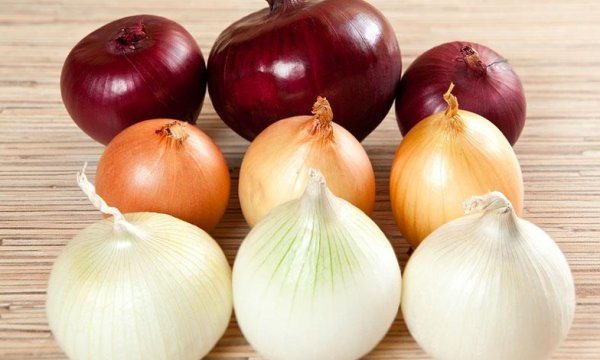

This variety ripens in about three months and is therefore called mid-season. Alvina gives a very good harvest. They are planted in the ground in the month of May to a depth of 4 cm. External distinctive features:
- ellipse shape;
- weight 70 - 150 g;
- the husk is purple;
- inside the bulb is white with a purple color.
The vegetable is not very spicy to taste, so it is preferable to eat it raw. Differs in good juiciness. The shelf life of this onion is 6-7 months.
Did you know? Variety "Alvina" contains a large amount of useful substances, including quartztin. Its peculiarity is that this supplement is able to prevent the appearance of tumors.
Is it possible during pregnancy and lactation?
Many foods are allowed during pregnancy, but in moderation. Do not give up vitamins and minerals. In this case, the contraindications are the same. It is necessary to limit the consumption of vegetables with a tendency to flatulence and in the second half of pregnancy.
If you like the onion, you should use it, especially since it provides additional fortification:
- Phytoncides eliminate microbes and fungi.
- Essential oils improve gastric acid production by restoring digestion.
- Folic acid prevents the appearance of fetal malformations.
- Minerals protect the musculoskeletal system and strengthen the nervous system.
- Magnesium prevents constipation.
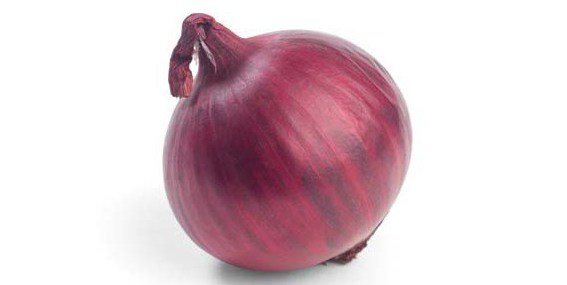

Purple onion maintains immunity, protects against anemia, vitamin deficiency. It is necessary to introduce a vegetable into the diet of a small child with caution: it is important to observe the reaction to the product.
Varieties
There are several varieties of purple onions:
- Red Baron. This variety has a yield of about 1.5 kg of vegetables per 1 sq. meters of land. The fruits are burgundy-blue in color, both on top and on the inside. The taste of the vegetable is bittersweet, the onion lasts until spring. Cultivation is carried out with sevk and seeds. From sowing to lodging of feathers, 95-100 days pass. Onions can be used for home cultivation and sale. Due to its unusual taste, it is used for salads, side dishes and soups.
- Black Prince. The onion variety has a huge yield. Up to 50 tons of vegetables can be harvested from 1 hectare. The onions are perfectly preserved in winter, they do not rot. Suitable for planting with sets and seeds. This vegetable has a burgundy, almost black color and a bitter taste. The variety is versatile, excellent for sale and consumption.
- Danilovskiy 301. This variety has an average ripening period, it has a good harvest. The onion has a purple color, weight 1 pc. is up to 150 g. Vegetables do not rot when stored properly. This is one of the delicious varieties that grow in central Russia.
- Commissioner. The onion is purple in color, the fruits are large. Stores in the closet for up to 6 months. With the fertility of the land and proper care, it is possible to obtain up to 3.3 kg of vegetables from 1 sq. meters.
- Alvina. Growing can be annual. Then you need to either sow seeds or plant seedlings. Vegetables are stored in the pantry for up to 7 months. The yield will be up to 2.6 kg from a garden in 1 sq. m.
All species, although they have a purple color, still differ in shades, properties, and taste. But each of them is good for human health.
Growing specifics
Culture propagation is carried out in three ways - by seeds, seedlings and seedlings. For a faster harvest, the last two options are used. With the seed method of reproduction, germination is carried out by placing the seeds in a moistened gauze one day before sowing.
When planting, they are buried by 1.5 cm, there are no special requirements for the soil, but it must be nutritious and light. After sowing, carefully watered and covered with foil to maintain the greenhouse effect. When the first sprouts appear, the film is removed, and the container with onions is placed on the windowsill or in any other bright, warm place.
Storage
Leave the vegetable in the husk box or in old stockings. He needs the following conditions:
- Dry, darkened room.
- Room temperature.
- Humidity up to 60%.
In the basement of a private house, onions must be stored at temperatures from -3 to +10 degrees. For a sweet variety, 0 degrees is suitable. At the same time, there must be ventilation in the basement or cellar. At a moisture content of 80% or more, the product deteriorates.For storage, you can use wooden boxes, cardboard boxes, baskets from a vine, bags, nets. Do not take plastic bags.


Vegetables are stored in the apartment - in the mezzanine or in the pantry. It is important that they have access to air. In an apartment, onions can be stored in the refrigerator, only before that they must be thoroughly dried. Compliance with these rules will allow you to have a fresh and healthy vegetable all year round.
Harvest
A couple of weeks before harvesting, the onions are completely stopped from watering. In most cases, the harvest time is written on the seed bags. However, experienced summer residents know that onions can be harvested as soon as the shoots have turned yellow and laid down.
After digging, the vegetable is left in the fresh air under a canopy to dry out, after which it can be cleaned of the remaining soil and stored.
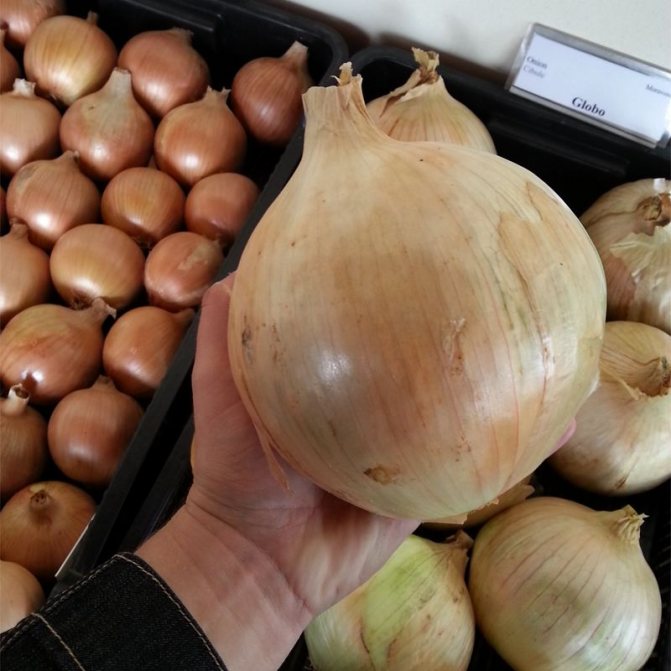

The Globo variety is distinguished by its impressive size.

